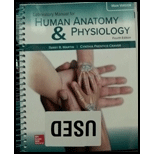
Laboratory Manual For Human Anatomy & Physiology
4th Edition
ISBN: 9781260159080
Author: Martin, Terry R., Prentice-craver, Cynthia
Publisher: Mcgraw-hill Education,
expand_more
expand_more
format_list_bulleted
Concept explainers
Textbook Question
Chapter 37, Problem 5PL
Which of the following structures is part of the inner ear?
a. tympanic membrane
b. cochlea
c. stapes
d. pharyngotympanic tube
Expert Solution & Answer
Want to see the full answer?
Check out a sample textbook solution
Students have asked these similar questions
Which of these structures is found within or is a part of the external ear?a. oval window c. ossicles e. cochlear ductb. auditory tube d. external auditory canal
Which one of these correctly describes the location of the spiral organ?
a. between the tympanic membrane and the oval window in theinner ear
b. in the utricle and saccule within the vestibule
c. between the tectorial membrane and the basilar membrane in thecochlear canal
d. between the nasal cavities and the throat
e. between the outer and inner ear within the semicircular canals
Mark the following statements as true or false. If a statement is false, correct it to make a true statement. a. The incus is connected to the tympanic membrane. b. The stapes is attached to the oval window. c. The auditory canal is separated from the middle ear by the round window. d. The cochlear duct is filled with perilymph. e. The semicircular ducts are connected to the utricle, and the cochlear duct is continuous with the saccule. f. The spiral organ is located in the scala tympani.
Chapter 37 Solutions
Laboratory Manual For Human Anatomy & Physiology
Ch. 37 - Hearing is interpreted in the lobe of the...Ch. 37 - Sound loudness is measured in a. pitch. b....Ch. 37 - The middle ear bones articulate from tympanic...Ch. 37 - The test is done to assess possible conduction...Ch. 37 - Which of the following structures is part of the...Ch. 37 - The pharyngotympanic tube connects the outer e to...Ch. 37 - The cochlear nerve serves as the hearing branch of...Ch. 37 - Endolymph is located within the cochlear duct of...Ch. 37 - FIGURE 37.9 Label the structures associated with...Ch. 37 - FIGURE 37.10 Identify the features indicated on...
Knowledge Booster
Learn more about
Need a deep-dive on the concept behind this application? Look no further. Learn more about this topic, biology and related others by exploring similar questions and additional content below.Similar questions
- 5. The pharyngotympanic (auditory) tubes are found in the A. nasopharynx. B. oropharynx. C. laryngopharynx. D. oral cavity.arrow_forwardWhich of the following has the fewest taste receptors? a. fungiform papillae b. circumvallate papillae c. foliate papillae d. filiform papillaearrow_forwardWhich of these is NOT a component of the middle ear? a. tympanic membrane b. eustachian (auditory) tube ¢ malleus, incus, stapes d. nasopharynx e. tympanic cavityarrow_forward
- The pharyngotympanic membrane A. Is also called the Eustachian tube B. Controls the pressure in the middle ear C. Connects the middle ear to the oropharynx D. A, B E. A, B, Carrow_forwardwhich statements are true about the Auditory Structures and Functions a. The external ear consists of the auricle and external acoustic meatus. b. The middle ear connects the external and inner ears. The tympanic membrane is stretched across the external acoustic meatus. c. The malleus, incus, and stapes connect the tympanic membrane to the oval window of the outer ear. d. The auditory tube connects the middle ear to the pharynx and functions to equalize pressure.arrow_forwardIf Tabitha closes her eyes when she rides in her parents’ car, she can still tell that the car is moving. This is due to the movement of tiny crystals in the a. outer ear. b. cochlea. c. otolith organs. d. middle ear.arrow_forward
- Which two of the following are part of the olfactory organs? a. olfactory receptor cells b. columnar epithelial cells in the nasal mucosa c. the brain d. the eyesarrow_forwardThe concave shell of the ear that is the deepest depression on the ear is located posterior and superior to the ear passage A. Crus B. Concha C. Crura of the antihelix D. Tragusarrow_forwardWhat is the “retina” of the olfactory system? a. The olfactory epithelium b. The olfactory bulb c. The nose d. Hair cellsarrow_forward
- Tiny crystals called --- in the inner ear are involved in maintaining equilibrium. A. crista ampullaris B. semicircular canals C. saccules. D. otolithsarrow_forwardInvolved in the transmission and processing of sound for hearing to take place A. Organ of Corti B. Vestibule C. Semicircular canals D. A, B E. A, B, Carrow_forwardWhen you begin to move up or down in an elevator, you can still sense that you are moving even though there are no visual cues. Which sensory organ would be most responsible for detecting this? a. Merkel cells b. Pacinian corpuscles c. Otolith organs d. Semicircular canalsarrow_forward
arrow_back_ios
SEE MORE QUESTIONS
arrow_forward_ios
Recommended textbooks for you
 Medical Terminology for Health Professions, Spira...Health & NutritionISBN:9781305634350Author:Ann Ehrlich, Carol L. Schroeder, Laura Ehrlich, Katrina A. SchroederPublisher:Cengage Learning
Medical Terminology for Health Professions, Spira...Health & NutritionISBN:9781305634350Author:Ann Ehrlich, Carol L. Schroeder, Laura Ehrlich, Katrina A. SchroederPublisher:Cengage Learning- Essentials of Pharmacology for Health ProfessionsNursingISBN:9781305441620Author:WOODROWPublisher:Cengage
 Cardiopulmonary Anatomy & PhysiologyBiologyISBN:9781337794909Author:Des Jardins, Terry.Publisher:Cengage Learning,
Cardiopulmonary Anatomy & PhysiologyBiologyISBN:9781337794909Author:Des Jardins, Terry.Publisher:Cengage Learning,



Medical Terminology for Health Professions, Spira...
Health & Nutrition
ISBN:9781305634350
Author:Ann Ehrlich, Carol L. Schroeder, Laura Ehrlich, Katrina A. Schroeder
Publisher:Cengage Learning


Essentials of Pharmacology for Health Professions
Nursing
ISBN:9781305441620
Author:WOODROW
Publisher:Cengage

Cardiopulmonary Anatomy & Physiology
Biology
ISBN:9781337794909
Author:Des Jardins, Terry.
Publisher:Cengage Learning,
The Sensorimotor System and Human Reflexes; Author: Professor Dave Explains;https://www.youtube.com/watch?v=M0PEXquyhA4;License: Standard youtube license